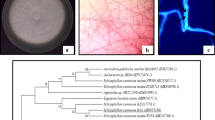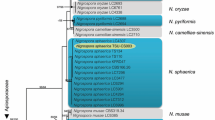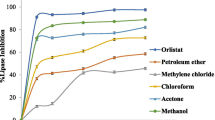Abstract
Diabetes is considered as a major health concern worldwide and patients with diabetes are at high risk for infectious diseases. Therefore, α-glucosidase inhibitors possessing antibacterial activity along with the ability to inhibit biofilms would be better therapeutic agents for diabetic patients. In the present study, two fractions (AF1 and AF2) possessing α-glucosidase inhibitory activity were purified from an endophytic fungus Alternaria destruens (AKL-3) isolated from Calotropis gigantea. These were evaluated for their antimicrobial and antibiofilm potential against human pathogens. AF1 exhibited broad spectrum antimicrobial activity against all the tested pathogens. It also significantly inhibited biofilm formation and dispersed the preformed biofilm at sub-optimal concentrations. AF2 possessed lesser activity as compared to AF1. The active compounds were purified using semi preparative HPLC. Some of the active compounds were identified to be phenolic in nature. The active fractions were also determined to be non-mutagenic and non-cytotoxic in safety analysis. The study highlights the role of endophytic fungi as sources of α-glucosidase inhibitors with antimicrobial potential which can have application in management of diabetes.






Similar content being viewed by others
Abbreviations
- AGI:
-
α-Glucosidase inhibitors
- BHI:
-
Brain heart infusion
- CHO:
-
Chinese hamster ovary
- DM:
-
Diabetes mellitus
- DMSO:
-
Dimethyl sulfoxide
- DOX:
-
Doxorubicin
- FTIR:
-
Fourier transform infrared spectroscopy
- HPLC:
-
High performance liquid chromatography
- MTT:
-
(3-(4, 5-Dimethylthiazol-2-yl)-2, 5-diphenyl-2H-tetrazolium bromide
- OD:
-
Optical density
- pNPG:
-
ρ-Nitro phenyl-α-d-glucopyranoside
- TLC:
-
Thin layer chromatography
References
Purich DL (2010) Enzyme kinetics: catalysis and control: a reference of theory and best-practice methods. Elsevier, Amsterdam
Asano N (2003) Glycosidase inhibitors: update and perspectives on practical use. Glycobiology 13(10):93R–104R
Kim SK, Nho HJ (2004) Isolation and characterization of α-glucosidase inhibitor from the fungus Ganoderma lucidum. J Microbiol 42(3):223–227
Kajimoto T, Node M (2009) Inhibitors against glycosidases as medicines. Curr Top Med Chem 9(1):13–33
Alonzi DS, Scott KA, Dwek RA, Zitzmann N (2017) Iminosugar antivirals: the therapeutic sweet spot. Biochem Soc Trans 45(2):571–582
Geerlings SE, Hoepelman AI (1999) Immune dysfunction in patients with diabetes mellitus (DM). FEMS Immunol Med Microbiol 26(3–4):256–265
Muller LMAJ, Gorter KJ, Hak E, Goudzwaard WL, Schellevis FG, Hoepelman AIM, Rutten GEHM (2005) Increased risk of common infections in patients with type 1 and type 2 diabetes mellitus. Clin Infect Dis 41(3):281–288
Neut D, Tijdens-Creusen EJ, Bulstra SK, Van der Mei HC, Busscher HJ (2011) Biofilms in chronic diabetic foot ulcers—a study of 2 cases. Acta Orthop 82(3):383–385
Jalgaonwala RE, Mohite BV, Mahajan RT (2017) A review: natural products from plant associated endophytic fungi. J Microbiol Biotechnol Res 1(2):21–32
Strobel GA, Daisy B (2003) Bioprospecting for microbial endophytes and their natural products. Microbiol Mol Biol Rev 67:491–502
Wibowo M, Prachyawarakorn V, Aree T, Wiyakrutta S, Mahidol C, Ruchirawat S, Kittakoop P (2014) Tricyclic and spirobicyclic norsesquiterpenes from the endophytic fungus Pseudolagarobasidium acaciicola. Eur J Org Chem 19:3976–3980
Wibowo M, Prachyawarakorn V, Aree T, Mahidol C, Ruchirawat S, Kittakoop P (2016) Cytotoxic sesquiterpenes from the endophytic fungus Pseudolagarobasidium acaciicola. Phytochemistry 122:126–138
Masi M, Maddau L, Linaldeddu BT, Scanu B, Evidente A, Cimmino A (2018) Bioactive metabolites from pathogenic and endophytic fungi of forest trees. Curr Med Chem 25(2):208–252
Singh B, Kaur T, Kaur S, Manhas RK, Kaur A (2016) Insecticidal potential of an endophytic Cladosporium velox against Spodoptera litura mediated through inhibition of alpha glycosidases. Pest Biochem Physiol 131:46–52
Singh B, Kaur A (2016) Antidiabetic potential of a peptide isolated from an endophytic Aspergillus awamori. J Appl Microbiol 120:301–311
Kaur J, Kaur R, Dutta R, Kaur S, Kaur A (2018) Exploration of insecticidal potential of an alpha glucosidase enzyme inhibitor from an endophytic Exophiala spinifera. J Appl Microbiol 125(5):1455–1465
Kaur J, Sharma A, Sharma M, Manhas RK, Kaur S, Kaur A (2019) Effect of α-glycosidase inhibitors from endophytic fungus Alternaria destruens on survival and development of insect pest Spodoptera litura Fab. and fungal phytopathogens. Sci Rep 9(1):1–13
Kaur S, Sharma P (2015) Protease-sensitive inhibitory activity of cell-free supernatant of Lactobacillus crispatus 156 synergizes with ciprofloxacin, moxifloxacin and streptomycin against Pseudomonas aeruginosa: an in vitro study. Probiot Antimicro 7(2):172–180
Djordjevic D, Wiedmann M, McLandsborough LA (2002) Microtiter plate assay for assessment of Listeria monocytogenes biofilm formation. Appl Environ Microbiol 68(6):2950–2958
Waksmundzka HM, Sherma J, Kowalska T (2008) Thin layer chromatography in phytochemistry. CRC Press, Boca Raton
Maron DM, Ames BN (1983) Revised method for Salmonella mutagenicity test. Mutat Res 113(3–4):173–215
Ciapetti G, Cenni E, Pratelli L, Pizzoferrato A (1993) In vitro evaluation of cell/biomaterial interaction by MTT assay. Biomaterials 14(5):359–364
Rehm BH (2010) Bacterial polymers: biosynthesis, modifications and applications. Nat Rev Microbiol 8(8):578
Islam B, Khan SN, Haque I, Alam M, Mushfiq M, Khan AU (2008) Novel anti-adherence activity of mulberry leaves: inhibition of Streptococcus mutans biofilm by 1-deoxynojirimycin isolated from Morus alba. J Antimicrob Chemother 62(4):751–757
Lee DS, Lee JM, Kim SU, Chang KT, Lee SH (2007) Ceftezole, a cephem antibiotic, is an α-glucosidase inhibitor with in vivo anti-diabetic activity. Int J Mol Med 20(3):379–383
Rupp ME, Hamer KE (1998) Effect of sub inhibitory concentrations of vancomycin, cefazolin, ofloxacin, L-ofloxacin and D-ofloxacin on adherence to intravascular catheters and biofilm formation by Staphylococcus epidermidis. J Antimicrob Chemother 41(2):155–161
Lou Z, Wang H, Zhu S, Ma C, Wang Z (2011) Antibacterial activity and mechanism of action of chlorogenic acid. J Food Sci 76(6):M398–M403
Bakkiyaraj D, Nandhini JR, Malath B, Pandian SK (2013) The anti-biofilm potential of pomegranate (Punica granatum L.) extract against human bacterial and fungal pathogens. Biofouling 29(8):929–937
Yamada Y, Yamamoto A, Yoneda N, Nakatani N (1999) Identification of kaempferol from the leaves of Diospyros kaki and its antimicrobial activity against Streptococcus mutans. Biocontrol Sci 4(2):97–100
Al-Majmaie S, Nahar L, Sharples GP, Wadi K, Sarker SD (2019) Isolation and antimicrobial activity of rutin and its derivatives from Ruta chalepensis (Rutaceae) growing in Iraq. Rec Nat Prod 13(1):64–70
Friedman M, Jurgens HS (2000) Effect of pH on the stability of plant phenolic compounds. J Agric Food Chem 48(6):2101–2110
Arabshahi DS, Devi DV, Urooj A (2007) Evaluation of antioxidant activity of some plant extract and their heat, pH and storage stability. Food Chem 100(3):1100–1105
Funding
Authors acknowledge the grant of fellowship under UPE (University with Potential for Excellence) scheme of University Grants Commission and Council of Scientific and Industrial Research (CSIR), New Delhi, India for providing financial assistance.
Author information
Authors and Affiliations
Corresponding author
Ethics declarations
Conflict of interest
The authors declare that they have no conflicts of interest.
Additional information
Publisher's Note
Springer Nature remains neutral with regard to jurisdictional claims in published maps and institutional affiliations.
Electronic supplementary material
Below is the link to the electronic supplementary material.
Rights and permissions
About this article
Cite this article
Kaur, J., Sharma, P., Kaur, R. et al. Assessment of alpha glucosidase inhibitors produced from endophytic fungus Alternaria destruens as antimicrobial and antibiofilm agents. Mol Biol Rep 47, 423–432 (2020). https://doi.org/10.1007/s11033-019-05145-3
Received:
Accepted:
Published:
Issue Date:
DOI: https://doi.org/10.1007/s11033-019-05145-3




